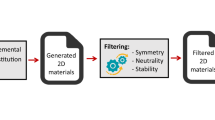Abstract
Molecular crystals cannot be designed in the same manner as macroscopic objects, because they do not assemble according to simple, intuitive rules. Their structures result from the balance of many weak interactions, rather than from the strong and predictable bonding patterns found in metal–organic frameworks and covalent organic frameworks. Hence, design strategies that assume a topology or other structural blueprint will often fail. Here we combine computational crystal structure prediction and property prediction to build energy–structure–function maps that describe the possible structures and properties that are available to a candidate molecule. Using these maps, we identify a highly porous solid, which has the lowest density reported for a molecular crystal so far. Both the structure of the crystal and its physical properties, such as methane storage capacity and guest-molecule selectivity, are predicted using the molecular structure as the only input. More generally, energy–structure–function maps could be used to guide the experimental discovery of materials with any target function that can be calculated from predicted crystal structures, such as electronic structure or mechanical properties.
This is a preview of subscription content, access via your institution
Access options
Access Nature and 54 other Nature Portfolio journals
Get Nature+, our best-value online-access subscription
$29.99 / 30 days
cancel any time
Subscribe to this journal
Receive 51 print issues and online access
$199.00 per year
only $3.90 per issue
Buy this article
- Purchase on Springer Link
- Instant access to full article PDF
Prices may be subject to local taxes which are calculated during checkout






Similar content being viewed by others

References
Lewis, D. W., Willock, D. J., Catlow, C. R. A., Thomas, J. M. & Hutchings, G. J. De novo design of structure-directing agents for the synthesis of microporous solids. Nature 382, 604–606 (1996)
Oganov, A. R. et al. Ionic high-pressure form of elemental boron. Nature 457, 863–867 (2009)
Ceder, G. et al. Identification of cathode materials for lithium batteries guided by first-principles calculations. Nature 392, 694–696 (1998)
Marleny Rodriguez-Albelo, L. et al. Zeolitic polyoxometalate-based metal−organic frameworks (Z-POMOFs): computational evaluation of hypothetical polymorphs and the successful targeted synthesis of the redox-active Z-POMOF1. J. Am. Chem. Soc. 131, 16078–16087 (2009)
Hachmann, J. et al. The Harvard Clean Energy Project: large-scale computational screening and design of organic photovoltaics on the World Community Grid. J. Phys. Chem. Lett. 2, 2241–2251 (2011)
Dyer, M. S. et al. Computationally assisted identification of functional inorganic materials. Science 340, 847–852 (2013)
Simon, C. M. et al. The materials genome in action: identifying the performance limits for methane storage. Energy Environ. Sci. 8, 1190–1199 (2015)
Ma, Y. et al. Transparent dense sodium. Nature 458, 182–185 (2009)
Sharma, V. et al. Rational design of all organic polymer dielectrics. Nat. Commun. 5, 4845 (2014)
Wilmer, C. E. et al. Large-scale screening of hypothetical metal–organic frameworks. Nat. Chem. 4, 83–89 (2012)
Jansen, M. & Schön, J. C. “Design” in chemical synthesis—an illusion? Angew. Chem. Int. Ed. 45, 3406–3412 (2006)
Cruz-Cabeza, A. J., Reutzel-Edens, S. M. & Bernstein, J. Facts and fictions about polymorphism. Chem. Soc. Rev. 44, 8619–8635 (2015)
Eddaoudi, M. et al. Systematic design of pore size and functionality in isoreticular MOFs and their application in methane storage. Science 295, 469–472 (2002)
Côté, A. P. et al. Porous, crystalline, covalent organic frameworks. Science 310, 1166–1170 (2005)
Woodley, S. M. & Catlow, R. Crystal structure prediction from first principles. Nat. Mater. 7, 937–946 (2008)
Price, S. L. Predicting crystal structures of organic compounds. Chem. Soc. Rev. 43, 2098–2111 (2014)
Mastalerz, M. Permanent porous materials from discrete organic molecules—towards ultra-high surface areas. Chem. Eur. J. 18, 10082–10091 (2012)
Kitaigorodskii, A. I. The principle of close packing and the condition of thermodynamic stability of organic crystals. Acta Crystallogr. 18, 585–590 (1965)
Jones, J. T. A. et al. Modular and predictable assembly of porous organic molecular crystals. Nature 474, 367–371 (2011)
Pyzer-Knapp, E. O. et al. Predicted crystal energy landscapes of porous organic cages. Chem. Sci. 5, 2235–2245 (2014)
Evans, J. D. et al. Computational identification of organic porous molecular crystals. CrystEngComm 18, 4133–4141 (2016)
Mastalerz, M. & Oppel, I. M. Rational construction of an extrinsic porous molecular crystal with an extraordinary high specific surface area. Angew. Chem. Int. Ed. 51, 5252–5255 (2012)
Wang, H. et al. A flexible microporous hydrogen-bonded organic framework for gas sorption and separation. J. Am. Chem. Soc. 137, 9963–9970 (2015)
Simard, M., Su, D. & Wuest, J. D. Use of hydrogen bonds to control molecular aggregation. Self-assembly of three-dimensional networks with large chambers. J. Am. Chem. Soc. 113, 4696–4698 (1991)
Kohl, B., Rominger, F. & Mastalerz, M. Crystal structures of a molecule designed not to pack tightly. Chem. Eur. J. 21, 17308–17313 (2015)
Zonta, C., De Lucchi, O., Linden, A. & Lutz, M. Synthesis and structure of D3h-symmetric triptycene trimaleimide. Molecules 15, 226–232 (2010)
Case, D. H., Campbell, J. E., Bygrave, P. J. & Day, G. M. Convergence properties of crystal structure prediction by quasi-random sampling. J. Chem. Theory Comput. 12, 910–924 (2016)
Cruz-Cabeza, A. J., Day, G. M. & Jones, W. Predicting inclusion behaviour and framework structures in organic crystals. Chem. Eur. J. 15, 13033–13040 (2009)
Gándara, F., Furukawa, H., Lee, S. & Yaghi, O. M. High methane storage capacity in aluminum metal–organic frameworks. J. Am. Chem. Soc. 136, 5271–5274 (2014)
Mason, J. A. et al. Methane storage in flexible metal–organic frameworks with intrinsic thermal management. Nature 527, 357–361 (2015)
Gómez-Gualdrón, D. A. et al. Evaluating topologically diverse metal–organic frameworks for cryo-adsorbed hydrogen storage. Energy Environ. Sci. 9, 3279–3289 (2016)
Côté, A. P., El-Kaderi, H. M., Furukawa, H., Hunt, J. R. & Yaghi, O. M. Reticular synthesis of microporous and mesoporous 2D covalent organic frameworks. J. Am. Chem. Soc. 129, 12914–12915 (2007)
Zhang, G., Presly, O., White, F., Oppel, I. M. & Mastalerz, M. A permanent mesoporous organic cage with an exceptionally high surface area. Angew. Chem. Int. Ed. 53, 1516–1520 (2014)
Materials Studio v.6.1.200, http://accelrys.com/products/collaborative-science/biovia-materials-studio/ (Accelrys Software Inc., 2012)
Frisch, M. J. et al. Gaussian 09 Revision D.01 (Gaussian Inc., 2013)
Price, S. L. et al. Modelling organic crystal structures using distributed multipole and polarizability-based model intermolecular potentials. Phys. Chem. Chem. Phys. 12, 8478–8490 (2010)
Pyzer-Knapp, E. O., Thompson, H. P. G. & Day, G. M. An optimized intermolecular force field for hydrogen-bonded organic molecular crystals using atomic multipole electrostatics. Acta Crystallogr. B72, 477–487 (2016)
Chisholm, J. A. & Motherwell, S. COMPACK: a program for identifying crystal structure similarity using distances. J. Appl. Cryst. 38, 228–231 (2005)
Willems, T. F., Rycroft, C., Kazi, M., Meza, J. C. & Haranczyk, M. Algorithms and tools for high-throughput geometry-based analysis of crystalline porous materials. Micropor. Mesopor. Mater. 149, 134–141 (2012)
Sesé, L. M. Feynman-Hibbs potentials and path integrals for quantum Lennard-Jones systems: theory and Monte Carlo simulations. Mol. Phys. 85, 931–947 (1995)
Spek, A. L. Structure validation in chemical crystallography. Acta Crystallogr. D65, 148–155 (2009)
Macrae, C. F. et al. Mercury CSD 2.0 – new features for the visualization and investigation of crystal structures. J. Appl. Cryst. 41, 466–470 (2008)
Dubbeldam, D., Calero, S., Ellis, D. E. & Snurr, R. Q. RASPA: molecular simulation software for adsorption and diffusion in flexible nanoporous materials. Mol. Simul. 42, 81–101 (2016)
Todorov, I. T., Smith, W., Trachenko, K. & Dove, M. T. DL_POLY_3: new dimensions in molecular dynamics simulations via massive parallelism. J. Mater. Chem. 16, 1911–1918 (2006)
Yong, C. W. Descriptions and implementations of DL_F notation: a natural chemical expression system of atom types for molecular simulations. J. Chem. Inf. Model. 56, 1405–1409 (2016)
Winn, P. J., Ferenczy, G. G. & Reynolds, C. A. Towards improved force fields. 1. Multipole-derived atomic charges. J. Phys. Chem. A 101, 5437–5445 (1997)
Ferenczy, G. G., Winn, P. J. & Reynolds, C. A. Towards improved force fields. 2. Effective distributed multipoles. J. Phys. Chem. A 101, 5446–5455 (1997)
Martin, M. G. MCCCS Towhee: a tool for Monte Carlo molecular simulation. Mol. Simul. 39, 1212–1222 (2013)
Acknowledgements
We acknowledge the European Research Council under the European Union’s Seventh Framework Programme (FP/2007-2013)/ERC through grant agreement numbers 321156 (ERC-AG-PE5-ROBOT) and 307358 (ERC-stG-2012-ANGLE), and EPSRC (grants EP/N004884/1, EP/K018396/1 and EP/K018132/1) for funding. This work made use of the facilities of N8 HPC Centre of Excellence, provided and funded by the N8 consortium and EPSRC (grant number EP/K000225/1). T.H. thanks the Royal Society for a University Research Fellowship. We thank Diamond Light Source for access to beamlines I19 (MT8728) and I11 (EE12336). We thank the Advanced Light Source, supported by the Director, Office of Science, Office of Basic Energy Sciences, of the US Department of Energy under contract number DE-AC02-05CH11231, and S. J. Teat and K. J. Gagnon for their assistance. We acknowledge the ARCHER UK National Supercomputing Service via the UK’s HEC Materials Chemistry Consortium membership and a Programme Grant, which are funded by EPSRC (grants EP/L000202 and EP/N004884), and use of the IRIDIS High Performance Computing Facility at the University of Southampton.
Author information
Authors and Affiliations
Contributions
A.P. performed the CSPs. T.K. synthesized T2 and isolated T2-γ. L.C. carried out the methane and hydrogen capacity simulations, the Qst calculations, the hydrocarbon separation simulations, the adsorption isotherm simulations and the IAST calculations. D.H. analysed the pore geometries for the predicted structures, produced most of the ESF maps and wrote scripts to analyse the data. S.Y.C. and M.A.L. isolated T2-β and T2-δ and carried out the PXRD experiments. S.Y.C. analysed the hydrogen-bonding patterns for T2. B.J.S. synthesized T1, T2 and T2E. B.B. developed the initial synthetic route to T2E. D.P.M. carried out the molecular dynamics stability and solvent stabilization calculations. M.A.L., C.J.S. and A.S. collected single-crystal X-ray diffraction data and solved the structures; M.A.L., S.Y.C., A.S. and B.J.S. performed experiments on the stability of various phases. M.A.L. isolated T2E-α, solved its crystal structure and led the single-crystal diffraction work. T.K., C.M.K. and B.J.S. carried out crystallization and sublimation studies for T1 and T2. T.K., R.C., M.A.L., A.S. and T.H. collected and interpreted the gas sorption isotherms. A.I.C. and G.M.D. conceived the project and the concept of ESF maps, and led the writing of the manuscript with contributions from all co-authors.
Corresponding author
Ethics declarations
Competing interests
The authors declare no competing financial interests.
Additional information
Reviewer Information Nature thanks R. Catlow and the other anonymous reviewer(s) for their contribution to the peer review of this work.
Supplementary information
Supplementary Information
This file contains Supplementary Methods, Supplementary Text and Data, Supplementary Figures 1-89, Supplementary Tables 1-12 and additional references. (PDF 15898 kb)
Rights and permissions
About this article
Cite this article
Pulido, A., Chen, L., Kaczorowski, T. et al. Functional materials discovery using energy–structure–function maps. Nature 543, 657–664 (2017). https://doi.org/10.1038/nature21419
Received:
Accepted:
Published:
Issue Date:
DOI: https://doi.org/10.1038/nature21419
This article is cited by
-
Supramolecular polynuclear clusters sustained cubic hydrogen bonded frameworks with octahedral cages for reversible photochromism
Nature Communications (2024)
-
Multistate structures in a hydrogen-bonded polycatenation non-covalent organic framework with diverse resistive switching behaviors
Nature Communications (2024)
-
Material Property Prediction Using Graphs Based on Generically Complete Isometry Invariants
Integrating Materials and Manufacturing Innovation (2024)
-
Bioinspired chiral inorganic nanomaterials
Nature Reviews Bioengineering (2023)
-
Topochemical polymerization of hydrogen-bonded organic framework for supporting ultrafine palladium nanoparticles
Science China Chemistry (2023)
Comments
By submitting a comment you agree to abide by our Terms and Community Guidelines. If you find something abusive or that does not comply with our terms or guidelines please flag it as inappropriate.


